Exploration of the Moon

The physicalexploration of the Moonbegan whenLuna 2,aspace probelaunched by theSoviet Union,made adeliberate impacton the surface of theMoonon September 14, 1959. Prior to that the only available means of lunar exploration had been observations from Earth. The invention of theoptical telescopebrought about the first leap in the quality of lunar observations.Galileo Galileiis generally credited as the first person to use a telescope for astronomical purposes, having made his own telescope in 1609, the mountains and craters on thelunar surfacewere among his first observations using it.
Human exploration of the moon since Luna 2 has consisted of both crewed and uncrewed missions.NASA'sApollo programhas been the only program tosuccessfully land humans on the Moon,which it did six times on the near side in the 20th century. The first human landing took place in 1969, when theApollo 11astronautsBuzz AldrinandNeil Armstrongtouched down on the lunar surface, leaving scientific instruments upon the mission's completion and returninglunar samplesto Earth.[1]All missions had taken place on the lunarnear sideuntil the first soft landing on thefar side of the Moonwas made by theCNSArobotic spacecraftChang'e 4in early 2019, which successfully deployed theYutu-2robotic lunar rover.[2][3]On 25 June 2024, China'sChang'e 6conducted the first lunar sample return from the far side of the Moon.[4]
The current goals of lunar exploration across all major space agencies now primarily focus on the continued survey of the lunar surface through various lunar missions in preparation for the eventual establishment of non-temporary human outposts.[5]
Before spaceflight[edit]
Theancient GreekphilosopherAnaxagoras,whose non-religious view of the heavens was one cause for his imprisonment and eventual exile,[6]reasoned that the Sun and Moon were both giant spherical rocks, and that the latter reflected the light of the former.Plutarch,in his bookOn the Face in the Moon's Orb,suggested that the Moon had deep recesses in which the light of the Sun did not reach and that the spots are nothing but the shadows of rivers or deep chasms. He also entertained the possibility that the Moon was inhabited.Aristarchusattempted to computethe Moon's size and distance from Earth, although his estimated distance of 20 timesEarth's radius(which had been accurately determined by his contemporaryEratosthenes) proved to be about a third the actual average distance.
Chinese philosophers of theHan Dynastybelieved the Moon to be energy equated toqibut recognized that the light of the Moon was a reflection of the Sun.[7]Mathematician and astrologerJing Fangnoted the sphericity of the Moon.[7]Shen Kuoof theSong Dynastycreated an allegory equating the wa xing and waning of the Moon to a round ball of reflective silver that, when doused with white powder and viewed from the side, would appear to be a crescent.[7]
Indian astronomerAryabhatastated in his fifth-century textAryabhatiyathat reflected sunlight is what causes the Moon to shine.[8]
Persian astronomerHabash al-Hasib al-Marwaziconducted various observations at theAl-Shammisiyyah observatoryinBaghdadbetween 825 and 835.[9]Using these observations, he estimated the Moon's diameter as 3,037 km (equivalent to 1,519 km radius) and its distance from the Earth as 346,345 km (215,209 mi).[9]In the 11th century, the Islamic physicistAlhazeninvestigated moonlight through a number of experiments and observations, concluding it was a combination of the Moon's own light and the Moon's ability to absorb and emit sunlight.[10][11]
By theMiddle Ages,before the invention of the telescope, an increasing number of people began to recognise the Moon as a sphere, though many believed that it was "perfectly smooth".[12]In 1609,Galileo Galileidrew one of the first telescopic drawings of the Moon in his bookSidereus Nunciusand noted that it was not smooth but had mountains and craters. Later in the 17th century,Giovanni Battista RiccioliandFrancesco Maria Grimaldidrew a map of the Moon and gave many craters the names they still have today. On maps, the dark parts of the Moon's surface were calledmaria(singularmare) or seas, and the light parts were calledterraeor continents.

Thomas Harriot,as well as Galilei, drew the first telescopic representation of the Moon and observed it for several years. His drawings, however, remained unpublished.[13]The first map of the Moon was made by the Belgian cosmographer and astronomerMichael van Langrenin 1645.[13]Two years later a much more influential effort was published byJohannes Hevelius.In 1647, Hevelius publishedSelenographia,the first treatise entirely devoted to the Moon. Hevelius's nomenclature, although used inProtestantcountries until the eighteenth century, was replaced by the system published in 1651 by theJesuitastronomerGiovanni Battista Riccioli,who gave the large naked-eye spots the names of seas and the telescopic spots (now called craters) the name of philosophers and astronomers.[13]
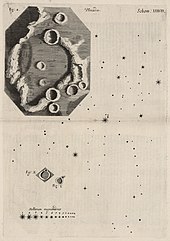
In 1753, the Croatian Jesuit and astronomerRoger Joseph Boscovichdiscovered the absence of atmosphere on the Moon. In 1824,Franz von Paula Gruithuisenexplained the formation of craters as a result ofmeteoritestrikes.[14]
The now disproven possibility that the Moon contains vegetation and is inhabited byseleniteswas seriously considered by major astronomers of the early modern period even into the first decades of the 19th century. In 1834–1836,Wilhelm BeerandJohann Heinrich Mädlerpublished their four-volumeMappa Selenographicaand the bookDer Mondin 1837, which firmly established the conclusion that the Moon has no bodies of water nor any appreciable atmosphere.[15]
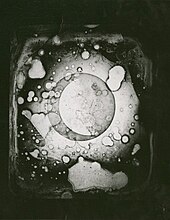
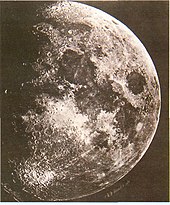
Space Race[edit]
TheCold War-inspired "space race"and"Moon race"between theSoviet Unionand theUnited States of Americaaccelerated with a focus on the Moon. This included many scientifically important firsts, such as the first photographs of the then-unseenfar side of the Moonin 1959 by the Soviet Union, and culminated with the landing of the first humans on the Moon in 1969, widely seen around the world as one of the pivotal events of the 20th century and of human history in general.
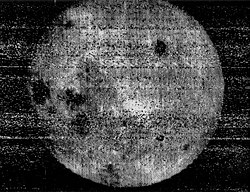


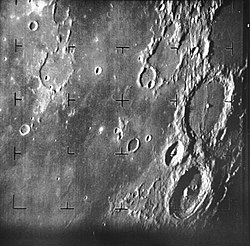







The first artificial object to fly by theMoonwas uncrewed Soviet probeLuna 1on January 4, 1959, and went on to be the first probe to reach aheliocentric orbitaround the Sun.[17]Few knew that Luna 1 was designed to impact the surface of the Moon.
The first probe to impact the surface of the Moon was the Soviet probeLuna 2,which made a hard landing on September 14, 1959, at 21:02:24 UTC. The far side of the Moon was first photographed on October 7, 1959, by the Soviet probeLuna 3.Though vague by today's standards, the photos showed that the far side of the Moon almost completely lackedmaria.
The first American probe to fly by the Moon wasPioneer 4on March 4, 1959, which occurred shortly after Luna 1. It was the only success of eight American probes that first attempted to launch for the Moon.[18]
In an effort to compete with these Soviet successes, U.S. PresidentJohn F. Kennedyproposed the Moon landing in aSpecial Message to the Congress on Urgent National Needs:
Now it is time to take longer strides – time for a great new American enterprise – time for this nation to take a clearly leading role in space achievement, which in many ways may hold the key to our future on Earth.
...For while we cannot guarantee that we shall one day be first, we can guarantee that any failure to make this effort will make us last.
...I believe that this nation should commit itself to achieving the goal, before this decade is out, of landing a man on the Moon and returning him safely to the Earth. No single space project in this period will be more impressive to mankind, or more important in the long-range exploration of space; and none will be so difficult or expensive to accomplish.
...let it be clear that I am asking the Congress and the country to accept a firm commitment to a new course of action—a course which will last for many years and carry very heavy costs...[19]Full text
Ranger 1launched in August 1961, just three months after President Kennedy's speech. It would be three more years and six failedRanger missionsuntilRanger 7returned close up photos of the Lunar surface before impacting it in July 1964. A number of problems with launch vehicles, ground equipment, and spacecraft electronics plagued theRanger programand early probe missions in general. These lessons helped inMariner 2,the only successful U.S. space probe after Kennedy's famous speech to congress and before his death in November 1963.[20]U.S.success ratesimproved greatly fromRanger 7onward.
In 1966, the USSR accomplished the first soft landings and took the first pictures from the lunar surface during theLuna 9andLuna 13missions.
The U.S. followed Ranger with theSurveyor program[21]sending sevenrobotic spacecraftto the surface of the Moon. Five of the seven spacecraft successfully soft-landed, investigating if theregolith(dust) was shallow enough for astronauts to stand on the Moon.
In September 1968 the Soviet Union'sZond 5sent tortoises on a circumlunar mission, followed by turtles aboardZond 6in November. On December 24, 1968, the crew ofApollo 8—Frank Borman,James LovellandWilliam Anders—became the first human beings to enter lunar orbit and see the far side of the Moon in person. Humans first landed on the Moon on July 20, 1969. The first humans to walk on the lunar surface wereNeil Armstrong,commander of the U.S. missionApollo 11and his fellow astronautBuzz Aldrin.
The first robotlunar roverto land on the Moon was the Soviet vesselLunokhod 1on November 17, 1970, as part of theLunokhod programme.To date, the last human to stand on the Moon wasEugene Cernan,who as part of theApollo 17mission, walked on the Moon in December 1972.
Moon rock sampleswere brought back to Earth by three Luna missions (Luna 16,20,and24) and the Apollo missions 11 through 17 (exceptApollo 13,which aborted its planned lunar landing).Luna 24in 1976 was thelast Lunar missionby either the Soviet Union or the U.S. untilClementinein 1994. Focus shifted toprobes to other planets,space stations,and theShuttle program.
Before the "Moon race," the U.S. had pre-projects for scientific and military moonbases: theLunex ProjectandProject Horizon.Besides crewed landings, the abandonedSoviet crewed lunar programsincluded the building of a multipurpose moonbase "Zvezda",the first detailed project, complete with developed mockups of expedition vehicles[22]and surface modules.[23]
After 1990[edit]
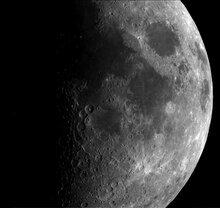
Japan[edit]
In 1990, Japan's JAXA visited the Moon with theHitenspacecraft, becoming the third country to place an object in orbit around the Moon. The spacecraft released theHagoromoprobe into lunar orbit, but the transmitter failed, thereby preventing further scientific use of the spacecraft. In September 2007, Japan launched theSELENEspacecraft, with the objectives "to obtain scientific data of the lunar origin and evolution and to develop the technology for the future lunar exploration", according to the JAXA official website.[24]
In 2023,Smart Lander for Investigating Moon(SLIM) is a lunar lander mission of theJapan Aerospace Exploration Agency(JAXA). By 2017, the lander was planned to be launched in 2021, but this was delayed until 2023 due to delays in SLIM's ride-share mission, X-Ray Imaging and Spectroscopy Mission (XRISM). It was successfully launched on 6 September 2023 at 23:42 UTC (7 September 08:42 Japan Standard Time). On 1 October 2023, the lander executed its trans-lunar injection burn. It entered orbit around the Moon on 25 December 2023, and landed on 19 January 2024 at 15:20 UTC. As a result, Japan became the fifth country to soft land on the surface of the Moon.[25]Since then, it has survived 4 lunar days and 3 lunar nights.[26]
European Space Agency[edit]
TheEuropean Space Agencylaunched a small, low-cost lunar orbital probe calledSMART 1on September 27, 2003. SMART 1's primary goal was to take three-dimensionalX-rayandinfrared imageryof the lunar surface. SMART 1 entered lunarorbiton November 15, 2004, and continued to make observations until September 3, 2006, when it was intentionally crashed into the lunar surface in order to study the impact plume.[27]
China[edit]
China has begun the Chinese Lunar Exploration Program for exploring the Moon and is investigating the prospect oflunar mining,specifically looking for theisotopehelium-3for use as an energy source on Earth.[28]China launched theChang'e 1robotic lunarorbiteron October 24, 2007. Originally planned for a one-year mission, the Chang'e 1 mission was very successful and ended up being extended for another four months. On March 1, 2009, Chang'e 1 was intentionally impacted on the lunar surface completing the 16-month mission. On October 1, 2010, China launched theChang'e 2lunar orbiter. China landed theroverYutuand theChang'e 3lander on the Moon on December 14, 2013, became the third country to have done so.[29]Chang'e 3 is the first spacecraft to soft-land on lunar surface sinceLuna 24in 1976. Since the Chang'e 3 mission was a success, the backup lander Chang'e 4 was re-purposed for the new mission goals. China launched on 7 December 2018 theChang'e 4mission to thelunar farside.[30]On January 3, 2019, Chang'e 4 landed on the far side of the Moon.[31]Chang'e 4 deployed theYutu-2Moon rover, which subsequently became the current record distance-holder for lunar surface travel.[32]Among other discoveries,Yutu-2found that the dust at some locations of the far side of the Moon is up to 12 meters deep.[33]
China planned to conduct asample return missionwith itsChang'e 5spacecraft in 2017, but that mission was postponed[34]due to the failure of theLong March 5launch vehicle.[35]However, after a successful return of flight by the Long March 5 rocket in late December 2019, China targeted itsChang'e 5sample return mission for late 2020.[36]China completed this mission on December 16, 2020, with the return of approximately 2 kilograms of lunar sample.[37]
China sentChang'e 6on 3 May 2024, which conducted the first lunar sample return fromApollo Basinon thefar side of the Moon.[38]This is China's second lunar sample return mission, the first was achieved byChang'e 5from the lunar near side four years earlier.[39]It also carried a Chinese rover calledYidong Xiangjito conductinfrared spectroscopyof lunar surface and imaged Chang'e 6 lander on lunar surface.[40]The lander-ascender-rover combination was separated with the orbiter and returner before landing on 1 June 2024 at 22:23 UTC. It landed on the Moon's surface on 1 June 2024.[41][42]The ascender was launched back to lunar orbit on 3 June 2024 at 23:38 UTC, carrying samples collected by the lander, and later completed another robotic rendezvous and docking in lunar orbit. The sample container was then transferred to the returner, which landed onInner Mongoliaon 25 June 2024, completing China's far side extraterrestrial sample return mission.
India[edit]

India's national space agency, theIndian Space Research Organisation,launchedChandrayaan-1,an uncrewed lunar orbiter, on October 22, 2008.[43]The lunar probe was originally intended to orbit the Moon for two years, with scientific objectives to prepare a three-dimensional atlas of the near and far side of the Moon and to conduct a chemical and mineralogical mapping of the lunar surface.[44]The orbiter released theMoon Impact Probewhich impacted the Moon at 15:04 GMT on November 14, 2008.[45]The orbitor was able to detect a widespread presence of water molecules in the lunar soil.[46]This mission was followed up byChandrayaan-2,which launched on July 22, 2019, and entered lunar orbit on August 20, 2019. Chandrayaan-2 also carried India's first lander and rover, but due to a last minute technical glitch in the landing system, the spacecraft crash-landed.[47]
Chandrayaan-2 was followed byChandrayaan-3,the third lunar exploration mission by the Indian Space Research Organisation. It also carried the lander named Vikram and the rover namedPragyan,and achieved the country's first soft landing near the south polar region of the Moon.[48][49][50]
United States[edit]
TheBallistic Missile Defense Organizationand NASA launched theClementine missionin 1994, andLunar Prospectorin 1998.

Lunar Reconnaissance Orbiter·Moon
NASA launched theLunar Reconnaissance Orbiter,on June 18, 2009, which has collected imagery of the Moon's surface. It also carried the Lunar Crater Observation and Sensing Satellite (LCROSS), which investigated the possible existence of water in the craterCabeus.GRAILis another mission, launched in 2011.
Following the decades-long lull in lunar exploration in the aftermath of the Cold War, the main push of US lunar exploration goals has coalesced under the Artemis program, formulated in 2017.[51]
Russia[edit]
On 10 August 2023, Russia launched theLuna 25mission, its first mission to the Moon since 1976.[52]On 20 August, it crashed into the Moon after a guidance error that resulted in an anomalous orbit lowering maneuver.[53]
South Korea[edit]
South Korea launched the lunar orbiterDanurion 4 August, 2022, and it arrived at the Moon on 16 December 2022. This is the first phase of South Korea's lunar exploration program, with plans to launch another lunar lander and probe.[54]
Pakistan[edit]
Pakistansent a lunar orbiter calledICUBE-Qalong with Chang'e 6.[55]
Commercial missions[edit]
In 2007, the X Prize Foundation together withGooglelaunched theGoogle Lunar X Prizeto encourage commercial endeavors to the Moon. A prize of $20 million was to be awarded to the first private venture to get to the Moon with a robotic lander by the end of March 2018, with additional prizes worth $10 million for further milestones.[56][57]As of August 2016, 16 teams were reportedly participating in the competition.[58]In January 2018 the foundation announced that the prize would go unclaimed as none of the finalist teams would be able to make a launch attempt by the deadline.[59]
In August 2016, the US government granted permission to US-based start-up Moon Express to land on the Moon.[60]This marked the first time that a private enterprise was given the right to do so. The decision is regarded as a precedent helping to define regulatory standards for deep-space commercial activity in the future. Previously, private companies were restricted to operating on or around Earth.[60]
On 29 November 2018, NASA announced that nine commercial companies would compete to win a contract to send small payloads to the Moon in what is known asCommercial Lunar Payload Services.According to NASA administratorJim Bridenstine,"We are building a domestic American capability to get back and forth to the surface of the moon.".[61]
The first commercial mission to the Moon was accomplished by theManfred Memorial Moon Mission(4M), led byLuxSpace,an affiliate of GermanOHB AG.The mission was launched on 23 October 2014 with the Chinese Chang'e 5-T1 test spacecraft, attached to the upper stage of aLong March 3C/G2 rocket.[62][63]The 4M spacecraft made a Moon flyby on a night of October 28, 2014, after which it entered elliptical Earth orbit, exceeding its designed lifetime by four times.[64][65]
TheBeresheetlander operated byIsrael Aerospace IndustriesandSpaceILimpacted the Moon on April 11, 2019, after a failed landing attempt.[66]
Plans[edit]
Following the abandoned USConstellation program,plans for crewed flights followed bymoonbaseswere declared by Russia,ESA,China, Japan, India, South Korea. All of them intend to continue the exploration of Moon with more uncrewed spacecraft.
India is planning and it is studying a potential collaboration with Japan to launch theLunar Polar Exploration Missionin 2026–28.
Russia also announced plans to resume its previously frozen projectLuna-Glob,an uncrewed lander and orbiter, which was slated to launch in 2021 but did not manifest.[67]In 2015,Roscosmosstated that Russia plans to place an astronaut on the Moon by 2030, leaving Mars to NASA. The purpose is to work jointly with NASA and avoid a space race.[68]A RussianLunar Orbital Stationhas been proposed to orbit around the Moon after 2030.
In 2018, NASA released plans to return to the Moon with commercial and international partners as part of an overall agency Exploration Campaign in support ofSpace Policy Directive 1,giving rise to theArtemis programand theCommercial Lunar Payload Services(CLPS). NASA plans to start with robotic missions on the lunar surface, as well as the crewedLunar Gateway.As of 2019, NASA is issuing contracts to develop new small lunar payload delivery services, develop lunar landers, and conduct more research on the Moon's surface ahead of a human return.[69]Artemis program involves several flights of theOrion spacecraftand lunar landings from 2022 to 2028.[70][71]
On November 3, 2021, NASA announced it had picked a landing site in the lunar south polar region near the craterShackletonfor an uncrewed spacecraft that included NASA's Polar Resources Ice-Mining Experiment-1. The precise location was termed the Shackleton Connecting Ridge, which features the advantage of near-continuous solar exposure and line-of-sight with Earth for communication.[72]
ESA'sMoonlight Initiativeaims to create a small network of communication and navigation satellites orbiting the Moon to support the Artemis landings.[73]These would enable communication with Earth even when out of direct line-of-sight. They would also provide navigation signals similar to theGlobal Positioning Systemon Earth, requiring precision timekeeping. Moonlight planners have proposed creating a new time zone for the Moon for this purpose, culminating in the introduction of theCoordinated Lunar Timestandard in 2024.[74]Due to the lower gravity and relative motion,time passes more quickly on the Moon,making every 24-hour period elapse 56 microseconds early when measured from Earth.[75]
See also[edit]
- Artemis program
- Colonization of the Moon
- Tourism on the Moon
- Lunar outpost (NASA)
- International Lunar Exploration Working Group
- List of artificial objects on the Moon
- List of Apollo astronauts
- List of lunar probes
- List of missions to the Moon
- Lunar resources
- Moon landing
- Timeline of Solar System exploration
- Starship HLS
References[edit]
- ^"Lunar Sample Overview".Lunar and Planetary Institute.Archivedfrom the original on February 7, 2021.RetrievedDecember 28,2018.
- ^Lyons, Kate."Chang'e 4 landing: China probe makes historic touchdown on far side of the moon".The Guardian.Archivedfrom the original on January 3, 2019.RetrievedJanuary 3,2019.
- ^"China successfully lands Chang'e-4 on far side of Moon".Archivedfrom the original on January 3, 2019.RetrievedJanuary 3,2019.
- ^Jones, Andrew (January 10, 2024)."China's Chang'e-6 probe arrives at spaceport for first-ever lunar far side sample mission".SpaceNews.Archivedfrom the original on May 3, 2024.RetrievedJune 25,2024.
- ^Dangwal, Ashish (November 22, 2023)."1st Country With Lunar Outpost, Competition 'Heating-Up' Between US-Led Artemis & China's ILRS".Latest Asian, Middle-East, EurAsian, Indian News.RetrievedMay 5,2024.
- ^O'Connor, J.J.; Robertson, E.F. (February 1999)."Anaxagoras of Clazomenae".University of St Andrews.RetrievedApril 12,2007.
- ^abcNeedham, Joseph (1986).Mathematics and the Sciences of the Heavens and Earth.Science and Civilization in China. Vol. 3. Taipei: Caves Books. p. 227; 411–416.ISBN978-0-521-05801-8.
- ^Hayashi (2008),Aryabhata I
- ^abLangermann, Y. Tzvi (1985). "The Book of Bodies and Distances of Habash al-Hasib".Centaurus.28(2): 111–112.Bibcode:1985Cent...28..108T.doi:10.1111/j.1600-0498.1985.tb00831.x.
- ^Toomer, G. J. (December 1964). "Review:Ibn al-Haythams Weg zur Physikby Matthias Schramm ".Isis.55(4): 463–465.doi:10.1086/349914.
- ^Montgomery, Scott L. (1999).The Moon & the Western Imagination.University of Arizona Press. pp. 75–76.ISBN9780816519897.
- ^Van Helden, A. (1995)."The Moon".Galileo Project. Archived fromthe originalon June 23, 2004.RetrievedApril 12,2007.
- ^abc"The Galileo Project".Archived fromthe originalon September 5, 2007.RetrievedSeptember 14,2007.
- ^Энциклопедия для детей (астрономия).Москва: Аванта+. 1998.ISBN978-5-89501-016-7.
- ^Erich Robens; Stanislaw Halas (February 16, 2009)."Study on the Possible Existence of Water on the Moon"(PDF).Geochronometria.33(–1): 23–31.Bibcode:2009Gchrm..33...23R.doi:10.2478/v10003-009-0008-2.RetrievedApril 9,2023.
- ^"First image of the Moon taken by a U.S. spacecraft".NSAS NSSDC Image Catalog.RetrievedSeptember 7,2020.
- ^"Luna 1".NASA Space Science Data Coordinated Archive.
- ^NASA.gov
- ^Kennedy, John F. (May 25, 1961).Special Message to Congress on Urgent National Needs(Motion picture (excerpt)). Boston, MA: John F. Kennedy Presidential Library and Museum. Accession Number: TNC:200; Digital Identifier: TNC-200-2.RetrievedAugust 1,2013.
- ^NASA.gov
- ^NASA.gov– 24 January 2020
- ^"LEK Lunar Expeditionary Complex".astronautix.Archived fromthe originalon December 8, 2013.RetrievedJune 12,2015.
- ^"DLB Module".astronautix.Archived fromthe originalon January 7, 2014.RetrievedJune 12,2015.
- ^"Kaguya (SELENE)".JAXA.RetrievedJune 25,2007.
- ^Sample, Ian (January 19, 2024)."Japan's Slim spacecraft lands on moon but struggles to generate power".The Guardian.ISSN0261-3077.Archivedfrom the original on January 19, 2024.RetrievedJanuary 20,2024.
- ^Crane, Leah."Japan's SLIM moon lander has shockingly survived a third lunar night".New Scientist.RetrievedApril 25,2024.
- ^"SMART-1 Impacts Moon".ESA. September 4, 2006. Archived fromthe originalon October 25, 2006.RetrievedSeptember 3,2006.
- ^David, Leonard (March 4, 2003)."China Outlines its Lunar Ambitions".Space. Archived fromthe originalon March 16, 2006.RetrievedMarch 20,2006.
- ^Sun, Zezhou; Jia, Yang; Zhang, He (2013). "Technological advancements and promotion roles of Chang'e-3 lunar probe mission".Sci China Tech Sci.56(11): 2702.Bibcode:2013ScChE..56.2702S.doi:10.1007/s11431-013-5377-0.S2CID111801601.
- ^China launches historic mission to land on far side of the MoonStephen Clark,Spaceflight Now.07 December 2018.
- ^Devlin, Hannah; Lyons, Kate (January 3, 2019)."Far side of the moon: China's Chang'e 4 probe makes historic touchdown".The Guardian.ISSN0261-3077.RetrievedJune 6,2019.
- ^China's Farside Moon Rover Breaks Lunar Longevity Record.Leonard David,Space.12 December 2019.
- ^Morgan McFall (26 Feb 2020) China's lunar rover finds nearly 40 feet of dust on the far side of the moon
- ^Nowakowski, Tomasz (August 9, 2017)."China Eyes Manned Lunar Landing by 2036".Archived fromthe originalon November 12, 2020.RetrievedAugust 17,2017.
- ^Jeff Foust (September 25, 2017)."Long March 5 failure to postpone China's lunar exploration program".SpaceNews.RetrievedDecember 17,2017.
- ^Jones, Andrew (November 1, 2019)."China targets late 2020 for lunar sample return mission".SpaceNews.RetrievedJanuary 26,2020.
- ^"China's Chang'e-5 mission returns Moon samples".BBC News.December 16, 2020.RetrievedDecember 16,2020.
- ^Andrew Jones [@AJ_FI] (April 25, 2023)."China's Chang'e-6 sample return mission (a first ever lunar far side sample-return) is scheduled to launch in May 2024, and expected to take 53 days from launch to return module touchdown. Targeting southern area of Apollo basin (~43º S, 154º W)"(Tweet) – viaTwitter.
- ^Jones, Andrew (January 10, 2024)."China's Chang'e-6 probe arrives at spaceport for first-ever lunar far side sample mission".SpaceNews.RetrievedJanuary 10,2024.
- ^Jones, Andrew (May 6, 2024)."China's Chang'e-6 is carrying a surprise rover to the moon".SpaceNews.Archivedfrom the original on May 8, 2024.RetrievedMay 8,2024.
- ^Jones, Andrew (June 1, 2024)."Chang'e-6 lands on far side of the moon to collect unique lunar samples".SpaceNews.RetrievedJune 1,2024.
- ^Seger Yu [@SegerYu] (June 1, 2024)."Lạc nguyệt thời khắc 2024-06-02 06:23:15.861"(Tweet) (in Chinese) – viaTwitter.
- ^"NDTV: Perfect start, Chandrayaan-1 ready for next step".Archived fromthe originalon December 12, 2008.RetrievedMay 22,2009.
- ^"Chandrayaan-1 Scientific Objectives".Indian Space Research Organisation. Archived fromthe originalon October 12, 2009.
- ^"India sends probe on to the Moon".BBC. November 14, 2008.RetrievedNovember 16,2008.
- ^Lunar Missions Detect Water on MoonArchived2009-10-03 at theWayback Machine
- ^"Chandrayaan – 2 Latest Update – ISRO".isro.gov.in.Archived fromthe originalon September 8, 2019.RetrievedOctober 7,2019.
- ^Welle, Deutsche."India spacecraft first to land on moon's south pole".
- ^"India lands spacecraft near south pole of moon in historic first".amp.theguardian.August 24, 2023. Archived fromthe originalon August 24, 2023.RetrievedAugust 25,2023.
- ^Bureau, The Hindu (July 6, 2023)."Chandrayaan-3 launch on July 14, lunar landing on August 23 or 24".The Hindu.ISSN0971-751X.RetrievedAugust 25,2023.
- ^
 One or more of the preceding sentences incorporates text from this source, which is in thepublic domain:"NASA: Moon to Mars".nasa.gov.NASA.Archivedfrom the original on August 5, 2019.RetrievedMay 19,2019.
One or more of the preceding sentences incorporates text from this source, which is in thepublic domain:"NASA: Moon to Mars".nasa.gov.NASA.Archivedfrom the original on August 5, 2019.RetrievedMay 19,2019.
- ^"Russia is back on the lunar path. A rocket blasts off on its first moon mission in nearly 50 years".August 11, 2023.
- ^Zak, Anatoly (August 19, 2023)."Luna-Glob mission lifts off".RussianSpaceWeb.RetrievedAugust 20,2023.
- ^"Danuri, South Korea's first Moon mission".The Planetary Society.
- ^Jones, Andrew (January 10, 2024)."China's Chang'e-6 probe arrives at spaceport for first-ever lunar far side sample mission".SpaceNews.RetrievedJanuary 10,2024.
- ^Chang, Kenneth (January 24, 2017)."For 5 Contest Finalists, a $20 Million Dash to the Moon".The New York Times.ISSN0362-4331.Archivedfrom the original on July 15, 2017.RetrievedJuly 13,2017.
- ^Wall, Mike (August 16, 2017),"Deadline for Google Lunar X Prize Moon Race Extended Through March 2018",space,archivedfrom the original on September 19, 2017,retrievedSeptember 25,2017
- ^McCarthy, Ciara (August 3, 2016)."US startup Moon Express approved to make 2017 lunar mission".The Guardian.ISSN0261-3077.Archivedfrom the original on July 30, 2017.RetrievedJuly 13,2017.
- ^"An Important Update From Google Lunar XPRIZE".Google Lunar XPRIZE.January 23, 2018. Archived fromthe originalon January 24, 2018.RetrievedMay 12,2018.
- ^ab"Moon Express Approved for Private Lunar Landing in 2017, a Space First".Space.Archived fromthe originalon July 12, 2017.RetrievedJuly 13,2017.
- ^Chang, Kenneth (November 29, 2018)."NASA's Return to the Moon to Start With Private Companies' Spacecraft".The New York Times.Archivedfrom the original on December 1, 2018.RetrievedNovember 29,2018.
- ^"First commercial mission to the Moon launched from China".Spaceflight Now. October 25, 2014.RetrievedJuly 24,2015.
- ^"China Readies Moon Mission for Launch Next Week".Space. October 14, 2014.RetrievedJuly 24,2015.
- ^"Saft lithium batteries powered the 4M mini-probe to success on the world's first privately funded Moon mission"(Press release).paris:Saft.January 21, 2015. Archived fromthe originalon July 24, 2015.RetrievedJuly 24,2015.
- ^Moser, H.A.; Ruy, G.; Schwarzenbarth, K.; Frappe, J.-B.; Basesler, K.; Van Shie, B. (August 2015)."Manfred Memorial Moon Mission (4M): development, operations, and results of a privately funded, low cost lunar flyby".29th Annual AIAA/USU Conference on Small Satellites.RetrievedApril 9,2023.
- ^Lidman, Melanie."Israel's Beresheet spacecraft crashes into the moon during landing attempt".timesofisrael.RetrievedOctober 7,2019.
- ^Covault, Craig (June 4, 2006)."Russia Plans Ambitious Robotic Lunar Mission".
- ^"Russia to place man on Moon by 2030 leaving Mars to NASA".June 27, 2015.
- ^Warner, Cheryl (April 30, 2018)."NASA Expands Plans for Moon Exploration".NASA.RetrievedApril 1,2019.
- ^"National Space Exploration Campaign Report" (PDF). NASA. September 2018.
- ^"Moon to Mars | NASA".June 25, 2018.RetrievedJune 10,2019.
- ^"NASA picks landing site at the moon's south pole for ice-drilling robot".Space.November 5, 2021.
- ^What is ESA’s Moonlight initiative?
- ^Ramirez-Simon, Diana (April 3, 2024)."Moon Standard Time? Nasa to create lunar-centric time reference system".The Guardian.ISSN0261-3077.RetrievedApril 4,2024.
- ^If daylight saving time seems tricky, try figuring out the time on the moon




